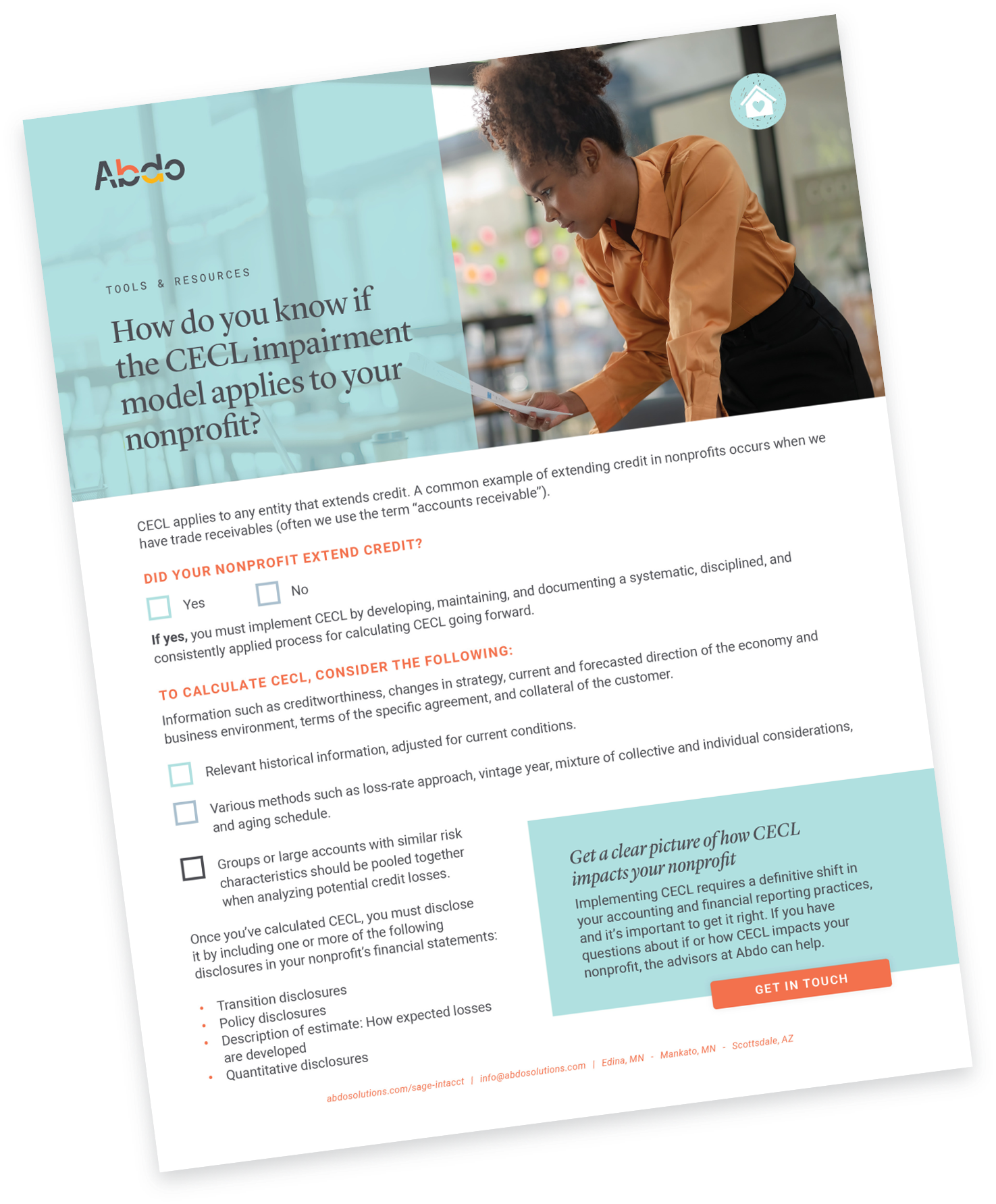Article
How will CECL impact your nonprofit?
May 14, 2024
by Hannah Hugen

When the Financial Standards Accounting Board’s (FASB’s) credit loss accounting standard, ASU 2016-13, went into effect in late 2022, you may have not paid much attention. After all, the standard applies mostly to banks…right?
Well, mostly.
Although the standard’s new current expected credit loss (CECL) impairment model has a direct impact on financial institutions, nonprofits—particularly those that have trade receivables—are not spared from its effects.
Here’s how CECL could impact your nonprofit.
What is CECL?
Under FASB’s previous impairment guidance (ASC-310-10), losses on financial assets were recognized upon becoming probable that a loss had been incurred.
Then FASB issued the new guidance (ASC 326-55). Effective for fiscal years beginning after December 15, 2022, all entities are now required to measure expected credit losses for all financial assets on the balance sheet date using the CECL model.
Does CECL apply to your nonprofit?
CECL applies to any entity that extends credit. A common example of extending credit in nonprofits occurs when we have trade receivables (often we use the term “accounts receivable”).
It is important to note that a trade receivable consists only of receivables generated from exchange transactions, i.e. revenue earned in which each side receives commensurate value. Trade receivables do not include contribution or pledges receivable, as these aren’t considered extensions of credit since the donor does not receive commensurate value in return for their contribution.
Here’s one example of how you could create a trade receivable: Your nonprofit sells t-shirts and payments are due 30 days after the sale. In this situation, the customer is receiving the t-shirt, and your nonprofit is receiving the revenue. Since the customer credit has been extended for 30 days, CECL applies and an allowance for credit losses may be applicable.
Other examples could be receivables for tuition, memberships, program service fees, etc. As mentioned, CECL does not apply to contributions receivable, such as pledges, gifts, donations, and, in most cases, grants.
How do you implement CECL?
Generally Accepted Accounting Principles (GAAP) requires entities to develop, maintain, and document a systematic, disciplined, and consistently applied process for calculating CECL going forward. This requires you to look at how you’re creating the allowance and consider several factors that may affect it.
Considerations for estimating CECL include the following:
- Information such as creditworthiness, changes in strategy, current and forecasted direction of the economy and business environment, terms of the specific agreement, and collateral of the customer.
- Relevant historical information, adjusted for current conditions.
- Various methods such as loss-rate approach, vintage year, mixture of collective and individual considerations, and aging schedule.
- Groups or large accounts with similar risk characteristics should be pooled together when analyzing potential credit losses.
How do you disclose CECL?
As a result of the new CECL standard, you may be required to include the following types of disclosures in your financial statements:
- Transition disclosures
- Policy disclosures
- Description of estimate: How expected losses are developed
- Quantitative disclosures
Get a clear picture of how CECL impacts your nonprofit.
 Implementing CECL requires a definitive shift in your accounting and financial reporting practices, and it’s important to get it right. If you have questions about if or how CECL impacts your nonprofit, the advisors at Abdo can help.
Implementing CECL requires a definitive shift in your accounting and financial reporting practices, and it’s important to get it right. If you have questions about if or how CECL impacts your nonprofit, the advisors at Abdo can help.
From talking to your auditor to determine which considerations are relevant to your CECL estimates to sending your examples of disclosures, we can guide you through the transition. We can even send you a generalized template for your disclosures, so you’re ready for your next audit.
For clarity around how CECL could impact your nonprofit, we’ve created a helpful checklist tool which you can access using the link below. Once you’ve reviewed the tool, contact us to discuss your unique circumstances and how our team can help.
Meet the Expert
How to make the most of your organization’s in-kind contributions
Despite being non-financial, non-cash donations (a.k.a. in-kind contributions) can help...
Non-monetary donations: What to do with kindness in-kind
Non-cash donations to a nonprofit organization are called in-kind contributions,...
